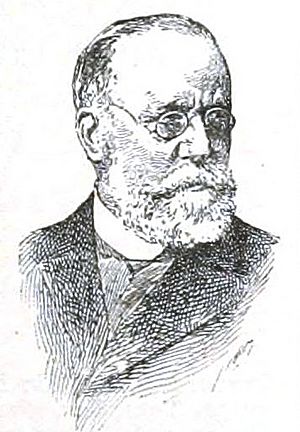Wilhelm von Bezold facts for kids
Quick facts for kids
Johann Friedrich Wilhelm von Bezold
|
|
|---|---|
 |
|
| Born | June 21, 1837 |
| Died | February 17, 1907 (aged 69) |
| Occupation | Physicist, meteorologist |
| Known for | Bezold effect, Bezold-Brücke shift |
Johann Friedrich Wilhelm von Bezold (born June 21, 1837 – died February 17, 1907) was a German scientist. He was a physicist, who studies how matter and energy work, and a meteorologist, who studies the weather. He was born in Munich, which was then part of the Kingdom of Bavaria.
Bezold is famous for discovering two interesting things about how we see colors: the Bezold effect and the Bezold–Brücke shift.
Contents
Early Life and Education
Wilhelm von Bezold studied mathematics and physics at two important universities in Germany. He went to the University of Munich and the University of Göttingen. These studies helped him understand the world around us.
Teaching and Research
After his studies, Bezold started teaching. From 1861, he taught about the weather in Munich. He became a full professor in 1866. A professor is a high-level teacher at a university.
In 1868, he began teaching at the Technical University of Munich. His work was recognized, and in 1875, he became a member of the Bavarian Academy of Sciences. This is a group of very smart people who advise on science.
Leading the Weather Institute
From 1885 to 1907, Bezold was the director of the Prussian Institute of Meteorology. This institute was located at the University of Berlin. As a scientist, he was very interested in how the atmosphere works. The atmosphere is the layer of air around Earth.
He greatly helped us understand electrical storms, like thunderstorms. He studied the physics behind them.
Understanding Atmospheric Thermodynamics
Bezold was one of the first scientists to study atmospheric thermodynamics. This is a field that looks at how heat and energy move in the atmosphere.
He studied something called "pseudo-adiabatic processes." This describes what happens to air as it rises in the sky. When air rises, it expands and cools down. This cooling can cause the water vapor in the air to turn into liquid water, forming clouds and eventually rain or snow.
Impact on Other Scientists
Bezold's research also helped other famous scientists. He investigated "Lichtenberg dust figures." These are patterns made by dust when electricity passes through a surface.
His work on these figures was useful to Heinrich Rudolf Hertz. Hertz was a scientist who worked on electromagnetic waves. These are waves that carry energy, like radio waves or light. Bezold's findings helped Hertz prove some of Maxwell's equations. These equations are important rules that describe how electricity and magnetism work together.
See also
 In Spanish: Wilhelm von Bezold para niños
In Spanish: Wilhelm von Bezold para niños

